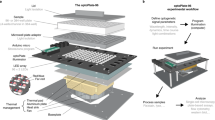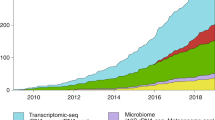Abstract
Mechanistic studies of cellular processes are usually carried out with large populations of cells. However, parameters that are measured as averages of large populations can be misleading. For instance, an apparently linear response to a signal could, in fact, reflect an increasing number of cells in the population that have switched from 'off' to 'on', rather than a graded increase in response by all the cells. At present, the study of single cells is challenging, but new technologies mean it might soon be a reality.
This is a preview of subscription content, access via your institution
Access options
Subscribe to this journal
Receive 12 print issues and online access
$209.00 per year
only $17.42 per issue
Buy this article
- Purchase on Springer Link
- Instant access to full article PDF
Prices may be subject to local taxes which are calculated during checkout





Similar content being viewed by others
References
McAdams, H. H. & Arkin, A. Stochastic mechanisms in gene expression. Proc. Natl Acad. Sci. USA 94, 814–819 (1997).
Swain, P. S., Elowitz, M. B. & Siggia, E. D. Intrinsic and extrinsic contributions to stochasticity in gene expression. Proc. Natl Acad. Sci. USA 99, 12795–12800 (2002).
Elowitz, M. B., Levine, A. J., Siggia, E. D. & Swain, P. S. Stochastic gene expression in a single cell. Scienc e 297, 1183–1186 (2002).
Blake, W. J., Kærn, M., Cantor, C. R. & Collins, J. J. Noise in eukaryotic gene expression. Nature 422, 633–637 (2003).
Gally, D. L. Environmental regulation of the fim switch controlling type 1 fimbrial phase variation in Escherichia coli K-12: effects of temperature and media. J. Bacteriol. 175, 6186–6193 (1993).
Schwan, W. R., Seifert, H. S. & Duncan, J. L. Growth conditions mediate differential transcription of fim genes involved in phase variation of type 1 pili. J. Bacteriol. 174, 2367–2375 (1992).
Orndorff, P. E. & Falkow, S. Identification and characterization of a gene product that regulates type 1 piliation in Escherichia coli. J. Bacteriol. 159, 736–744 (1984).
Klemm, P. Two regulatory fim genes, fimB and fimE, control the phase variation of type 1 fimbriae in Escherichia coli. EMBO J. 5, 1389–1393 (1986).
Arkin, A., Ross, J. & McAdams H. H. Stochastic kinetic analysis of developmental pathway bifurcation in phage lambda-infected Escherichia coli cells. Genetics 149, 1633–1648 (1998).
Novick, A. & Weiner, M. Enzyme induction as an all-or-none phenomenon. Proc. Natl Acad. Sci. USA 43, 553–566 (1957).
Maloney, P. C. & Rotman, B. Distribution of suboptimally induces -D-galactosidase in Escherichia coli. The enzyme content of individual cells. J. Mol. Biol. 73, 77–91 (1973).
Siegele, D. A. & Hu, J. C. Gene expression from plasmids containing the araBAD promoter at subsaturating inducer concentrations represents mixed populations. Proc. Natl Acad. Sci. USA 94, 8168–8172 (1997).
Kamme, F. et al. Single-cell microarray analysis in Hippocampus CA1: demonstration and validation of cellular heterogeneity. Neuroscience 23, 3607–3615 (2003).
Ferrell, J. E. & Xiong, W. Bistability in cell signaling: how to make continuous processes discontinuous, and reversible processes irreversible. Chaos 11, 227–236 (2001).
Xu, X. H., Wan, Q., Kyriacou, S. V., Brownlow, W. J. & Nowak, M. E. Direct observation of substrate induction of resistance mechanism in Pseudomonas aeruginosa using single live cell imaging. Biochem. Biophys. Res. Commun. 305, 941–949 (2003).
Hakkila, K., Maksimow, M., Rosengren, A., Karp, M. & Virta, M. Monitoring promoter activity in a single bacterial cell by using green and red fluorescent proteins. J. Microbiol. Methods 54, 75–79 (2003).
Lansford, R., Bearman, G. & Fraser, S. E. Resolution of multiple green fluorescent protein color variants and dyes using two-photon microscopy and imaging spectroscopy. J. Biomed. Opt. 6, 311–318 (2001).
Lippincott-Schwartz, J. & Patterson, G. H. Development and use of fluorescent protein markers in living cells. Science 300, 87–91 (2003).
Weijer, C. J. Visualizing signals moving in cells. Science 300, 96–100 (2003).
Tolker-Nielsen, T. et al. Non-genetic population heterogeneity studied by in situ polymerase chain reaction. Mol. Microbiol. 27, 1099–1105 (1998).
Holmstrom K., Tolker-Nielsen, T. & Molin, S. Physiological states of individual Salmonella typhimurium cells monitored by in situ reverse transcription-PCR. J. Bacteriol. 181, 1733–1738 (1999).
Nwoguh, C. E., Harwood, C. R. & Barer, M. R. Detection of induced β-galactosidase activity in individual non-culturable cells of pathogenic bacteria by quantitative cytological assay. Mol. Microbiol. 17, 545–554 (1995).
Dovichi, N. J. & Pinkel, D. Analytical biotechnology. Tools to characterize cells and their contents. Curr. Opin. Biotechnol. 14, 3–4 (2003).
Pohl, H. A. Dielectrophoresis: The Behavior of Neutral Matter in Non-Uniform Electric Fields. (Cambridge Univ. Press, New York, 1978).
Meldrum, D. R. & Holl, M. R. Tech.Sight. Microfluidics. Microscale bioanalytical systems. Science 297, 1197–1198 (2002).
Weigl, B. H., Bardell, R. L. & Cabrera, C. R. Lab-on-a-chip for drug development. Adv. Drug Deliv. Rev. 55, 349–377 (2003).
Jain, K. K. Post-genomic applications of lab-on-a-chip and microarrays. Trends Biotechnol. 20, 184–185 (2002).
Wheeler, A. R. et al. Microfluidic device for single-cell analysis. Anal. Chem. 75, 3249–3254 (2003).
Windman, T. O., Wyatt, B. J. & Hayes, M. A. Microfluidics for ultrasmall-volume biological analysis. Adv. Chromatogr. 42, 241–267 (2003).
Thorsen, T., Maerkl, S. J. & Quake, S. R. Microfluidic large-scale integration. Science 298, 580–584 (2002).
McCarter, L. & Silverman, M. Surface-induced swarmer cell differentiation of Vibrio parahaemolyticus. Mol. Microbiol. 4, 1057–1062 (1990).
O'Toole, G. A., Gibbs, K. A., Hager, P. W., Phibbs, P. V. J. & Kolter, R. The global carbon metabolism regulator Crc is a component of a signal transduction pathway required for biofilm development by Pseudomonas aeruginosa. J. Bacteriol. 182, 425–431 (2000).
Otto, K., Norbeck, J., Larsson, T., Karlsson, K -A. & Hermansson, M. Adhesion of type 1-fimbriated Escherichia coli to abiotic surfaces leads to altered composition of outer membrane proteins. J. Bacteriol. 183, 2445–2453 (2001).
Grinnell, F. Fibroblast biology in three-dimensional collagen matrices. Trends Cell Biol. 13, 264–269 (2003).
Shrayer, D. P., Lukoff, H., King, T. & Calabresi, P. The effect of taurolidine on adherent and floating subpopulations of melanoma cells. Anticancer Drugs 14, 295–303 (2003).
Lutz, B. R., Chen, J. & Schwartz, D. T. Microfluidics without microfabrication. Proc. Natl Acad. Sci. USA 100, 4395–4398 (2003).
Gascoyne, P. R. & Vykoukal, J. Particle separation by dielectrophoresis. Electrophoresis 23, 1973–1983 (2002).
Hughes, M. P. Strategies for dielectrophoretic separation in laboratory-on-a-chip systems. Electrophoresis 23, 2569–2582 (2002).
Chabinyc, M. L. et al. An integrated fluorescence detection system in poly(dimethylsiloxane) for microfluidic applications. Anal. Chem. 73, 4491–4498 (2001).
Fu, A. Y., Spence, C., Scherer, A., Arnold, F. H. & Quake, S. R. A microfabricated fluorescence-activated cell sorter. Nature Biotechnol. 17, 1109–1111 (1999).
Marquardt, B. J., Vahey, P. G., Synovec, R. E. & Burgess, L. W. A Raman waveguide detector for liquid chromatography. Anal. Chem. 71, 4808–4814 (1999).
Vahey, P. G. et al. Toward a fully integrated positive-pressure driven microfabricated liquid analyzer. Anal. Chem. 74, 177–184 (2001).
Nenninger, G. G., Clendenning, J. B., Furlong, C. E. & Yee, S. S. Reference-compensated biosensing using a dual-channel surface plasmon resonance sensor system based on a planar lightpipe configuration. Sens. Actuators B Chem. 51, 38–45 (1998).
Isaacs, F. J., Hasty, J., Cantor, C. R. & Collins, J. J. Prediction and measurement of an autoregulatory genetic module. Proc. Natl Acad. Sci. USA 100, 7714–7719 (2003).
Lidstrom, M. E. in The Prokaryotes, An Evolving Electronic Resource for the Microbiological Community. (eds Balows et al., Springer–Verlag, New York) [online], (cited 15 Sep 2003), <http://141.150.157.117:8080/prokPUB/chaprender/jsp/showchap.jsp?chapnum=300&initsec=02_01> (2003).
Park, P. U., McVey, M. & Guarente, L. Separation of mother and daughter cells. Methods Enzymol. 351, 468–477 (2002).
Hu, S. et al. Cell cycle-dependent protein fingerprint from a single cancer cell: image cytometry coupled with single-cell capillary sieving electrophoresis. Analyt. Chem. (in the press).
Cookson, B. T. & Brennan, M. A. Pro-inflammatory programmed cell death. Trends Microbiol. 9, 113–114 (2001).
Böhringer, K. F. Surface modification and modulation in microstructures: controlling protein adsorption, monolayer desorption, and micro-self-assembly. IOP J. Micromech. Microeng. 13, S1–S10 (2003).
Sweet, I. R. et al. Continuous measurement of oxygen consumption by pancreatic islets. Diabetes Technol. Ther. 4, 661–672 (2002).
Tlili, C. et al. Fibroblast cells: a sensing bioelement for glucose detection by impedance spectroscopy. Anal. Chem. 75, 3340–3344 (2003).
Michels, D. A., Hu, S., Schoenherr, R. M., Eggertson, M. J. & Dovichi, N. J. Fully automated two-dimensional capillary electrophoresis for high sensitivity protein analysis. Mol. Cell. Proteomics 1, 69–74 (2002).
Acknowledgements
The work described in this article has been supported by funding through the National Human Genome Research Institute (NHGRI) Centers of Excellence in Genomic Sciences programme. We wish to acknowledge the important contributions of other Microscale Life Sciences Center investigators to this work: K. Böhringer, L. Burgess, B. Cookson, N. Dovichi, M. Holl, B. Marquardt, J. Mittler, J. Mullins, V. Vogel and D. Wilson.
Author information
Authors and Affiliations
Corresponding author
Supplementary information
41579_2003_BFnrmicro755_MOESM1_ESM.pdf
Online Figure | MLSC organizational pyramid. For the single-cell analysis group of the MLSC, application needs drive innovation in module and system-level development, and foundation technologies support system design and integration activities. The use of new technology creates new areas of experimental investigation. (PDF 24 kb)
Glossary
- DIELECTROPHORESIS
-
The induced motion of polarizable particles in non-uniform electric fields.
- ELECTROIMPEDENCE SPECTROSCOPIC METHODS
-
An analytical technique that supplies frequency response information for a variety of conducting materials. A signature is obtained that can be related to specific changes in conducting properties.
- MICROANALYTICAL SPECTROSCOPIC METHODS
-
Detection methods that are based on analysis of the energies and wavelengths of radiation emitted by atoms and molecules when particular physical conditions are applied to them, and which use small (sub-microlitre) volumes and low concentrations of analyte.
- MICROFLUIDICS
-
Fluidics in structures on micron and smaller-length scales, resulting in low turbulence, with laminar flows.
- MULTIANALYTE
-
Multiple chemicals to be analysed.
- STOCHASTICITY
-
Describes a phenomenon that obeys the laws of probability.
- SURFACE PLASMON RESONANCE
-
(SPR). A phenomenon that occurs when light is reflected off thin metal films. Although incident light is totally reflected, the electromagnetic field component penetrates a short (tens of nanometres) distance into a medium of a lower refractive index, thereby creating a type of wave that is known as an exponentially detenuating evanescent wave. If the interface between the media is coated with a thin layer of metal (gold), and light is monochromatic and p-polarized, the intensity of the reflected light is reduced at a specific incident angle producing a sharp shadow, called surface plasmon resonance.
Rights and permissions
About this article
Cite this article
Lidstrom, M., Meldrum, D. Life-on-a-chip. Nat Rev Microbiol 1, 158–164 (2003). https://doi.org/10.1038/nrmicro755
Issue Date:
DOI: https://doi.org/10.1038/nrmicro755
This article is cited by
-
Invert emulsions alleviate biotic interactions in bacterial mixed culture
Microbial Cell Factories (2023)
-
Sub-nanowatt microfluidic single-cell calorimetry
Nature Communications (2020)
-
Alginate Hydrogel Beads for Immobilizing Single Photosynthetic Cells
International Journal of Precision Engineering and Manufacturing (2020)
-
Measuring Single-Cell Phenotypic Growth Heterogeneity Using a Microfluidic Cell Volume Sensor
Scientific Reports (2018)
-
Simultaneous Multiparameter Cellular Energy Metabolism Profiling of Small Populations of Cells
Scientific Reports (2018)



